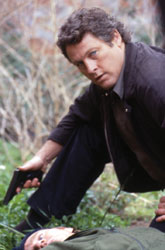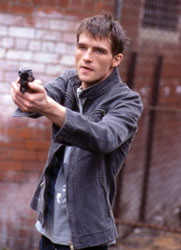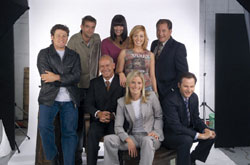A Police perspective - Arming the film industry
by Yolanda Corduff
Australian Shooter June 2004


 With firearms, weapons and special effects
used in so many films and television productions, it’s hardly surprising
that police services around the country have dedicated personnel to deal
with the fall-out.
With firearms, weapons and special effects
used in so many films and television productions, it’s hardly surprising
that police services around the country have dedicated personnel to deal
with the fall-out.
In Victoria, supervision of the film industry’s use of ‘weaponry’ falls to Vicki Vassilopoulos, who generally goes by the name Vicki ‘Vass’, and her small team at the Victoria Police Film and Television Office.
“We’ve worked on just about every major motion picture that’s been filmed in Victoria as well as many TV series and lots of TV commercials,” says Vicki Vass, who’s been with the Victoria Police for 14 years. “The Great Ocean Road, with its winding ocean views, has become particularly popular for car commercials, but we also regularly work on Stingers, Neighbours, Secret Life of Us, documentaries and a lot of international films too. One of our biggest regular assignments is Blue Heelers and I have one staff member on their set at all times. In fact, he pretty much works out of their offices, working with the show’s writers and cast members; he’s involved every step of the way with each episode that’s filmed.”
The Victoria Police Film and Television Office deals with a number of filming issues, from traffic management within the exterior perimeter of locations, including being responsible for public safety, vehicle traffic and liaising with local councils, to providing accurate research on police behaviour, policies and procedures.
“Police characters on screen seem to be very popular and writers prefer the actions and jargon to be as authentic as possible,” says Vass, noting that all research requests must be made in writing and include a copy of the script with all the questions that need answering. “This kind of research is a big component of our office and we have one full-time staff member working just in that area.”
Vass and her team also coordinate requests for onscreen appearances by police personnel and the use of police equipment on film sets, including the use of cars and other police resources.
“While the cars and police seen in the background of Australian productions are often real police and vehicles, we do charge out for these services, under our user pays system, with the fees set by the government,” says Vass.
A price list, available upon request, details the costs of hiring everything from police uniforms to personnel and resources. Prices start from $23.90 an hour for a car, with a minimum four-hour call-out fee, with staff call-out fees costing between $40.80 for junior officers to $63.50 for senior officers.
While much of the work done by the Victoria Police Film and Television Office may seem light-hearted, one of the more serious aspects is the use of firearms, weapons and special effects, such as pyrotechnics, by film and television productions.
“The use of firearms, or even pyrotechnics, when filming can produce a certain element of public concern,” explains Vass, adding that the unauthorised use of any firearm can potentially be a serious offence. “Members of the public who hear shooting or an explosion or see firearms being used will ring our ‘000’ number. When that happens, our response area dispatches out units to attend the location and investigate.
“If it’s a film shoot, the units still need to ensure the people involved are genuinely filming. Lengthy checks have to be made at these kind of ‘false’ call-outs and, while we don’t get a lot of false call-outs involving film crews, it has happened often enough that we recognise it as an issue that needs addressing,” she adds.
The main way firearms used in films and television are addressed is through a simple police notification process that Vass says can take as little as ten minutes.
“When people filming comply with our requirements by notifying us, we put through an internal communications report, which includes emailing the information to our ‘000’ area. The ‘000’ operators are then able to explain to concerned callers that a film shoot is taking place, which means we can clear the job quickly, rather than having it take up valuable police time and resources. Appropriate notification also makes it safer for the people involved in the filming because they don’t want police turning up, thinking they really are armed robbers!”
 Vass says it’s also important to use the services of a licensed theatrical armourer because purchasing firearms, even imitation firearms, for use in a film shoot can be a firearms offence.
Vass says it’s also important to use the services of a licensed theatrical armourer because purchasing firearms, even imitation firearms, for use in a film shoot can be a firearms offence.
“It doesn’t matter what kind of firearm is being used, we still need to be notified,” insists Vass, “because the average citizen in the community won’t be able to tell the difference between a real gun and a replica. In lectures we give to film students, we always tell them that they need to treat any scene involving firearms or imitation firearms like they’re real guns and like it’s a real scenario or situation with the possibility that police will turn up. And, therefore, they need to contact the police about it before any filming begins.”
Currently, the best way for people to notify police and to access information packages on the process of using firearms when filming is by contacting the police in their state or territory.
“We’re here to help in the production of films and television, not to create barriers, and we work really hard at communicating that throughout the industry and to the general community,” says Vass. “By ensuring people know we exist and what’s required when filming in Victoria, we’re able to attract filmmakers to our state by guaranteeing they can work in safety while keeping the process exciting and creative for everyone involved.”
The Victoria Police Film and Television Office deals with a number of filming issues, from traffic management within the exterior perimeter of locations, including being responsible for public safety, vehicle traffic and liaising with local councils, to providing accurate research on police behaviour, policies and procedures.
